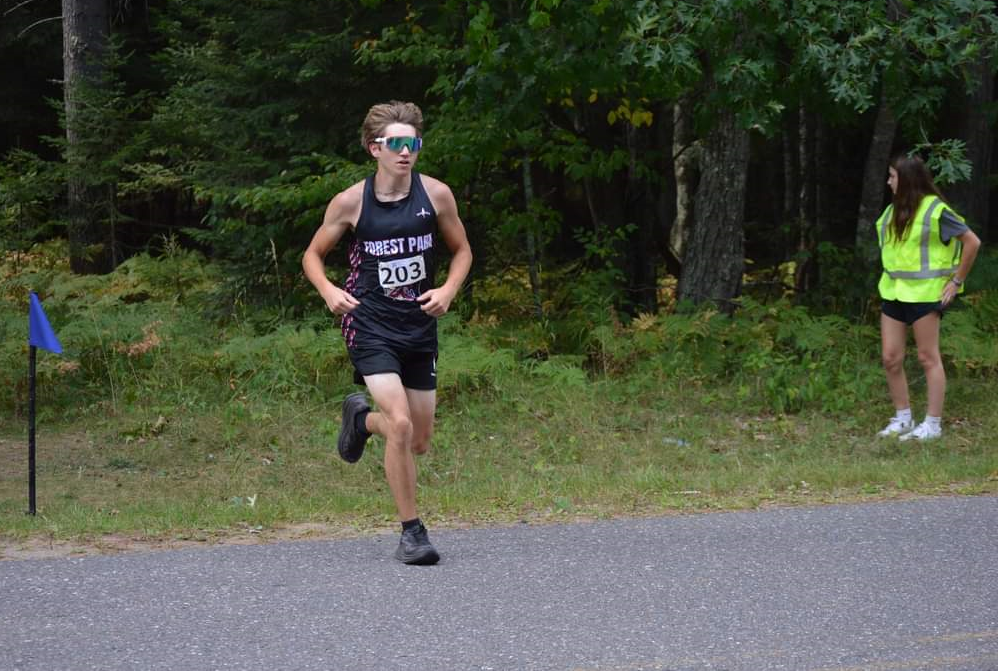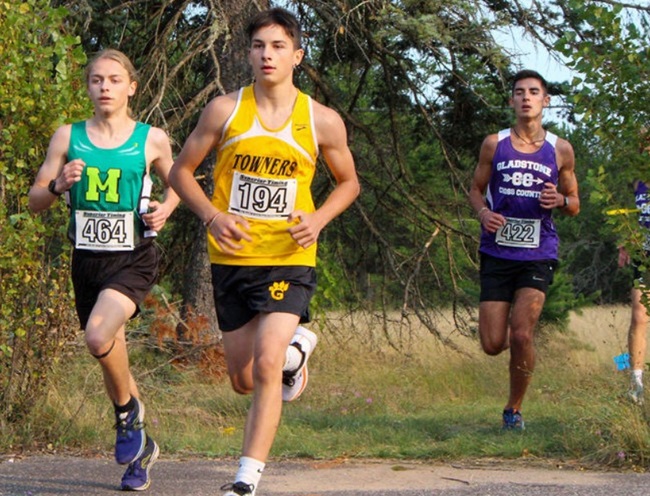
MHSAA Vault: MIS Rose to Challenges to Host 2020 LP Finals
By
Rob Kaminski
MHSAA benchmarks editor
November 12, 2021
The “MHSAA Vault” features stories from past publications and other documents in the MHSAA Library. This issue takes a look at the MHSAA Cross Country Finals at Michigan International Speedway, which celebrated 25 years in 2020 – although it was an event that nearly didn’t happen last fall …
In 1996, the MHSAA and Michigan International Speedway began a partnership the changed the course of the Lower Peninsula Cross Country Finals – quite literally.
The land in and around the track at Brooklyn would host the Finals for all classes of runners in one place on one day, an annual festival of nearly 2,000 runners competing for the MHSAA’s top honors.
Even skeptics – and there were several among running purists who thought the course was too flat, for example – can’t deny the results.
Finals attendance nearly doubled in that first year, and crowds in excess of 10,000 have enjoyed a day of racing several times, including a record 12,153 in 2011.
Enthusiastic crowds were the norm in recent years, with 11,232 in 2017, and nearly 11,000 in 2018 (10,989) and 2019 (10,873).
In fact, attendance failed to reach at least 8,000 only twice since the move to MIS.
Of course, last year was an exception, when attendance was limited to 1,000 spectators per session due to the COVID-19 Pandemic. Fans also were restricted to the grandstands rather than following the action throughout locations on the course.
To reduce the number of runners in each race, the event was spread over two days, with each Division being run in two separate “sections” with times then combined at the end to determine team and individual champions.
While not ideal, the end result was another year of fantastic efforts at MIS – both from student-athletes and those behind the scenes.
“Even at the last hour, less than a week ahead of the Finals, we were closer to not having the Finals than we were to having them,” said MHSAA Assistant Director Cody Inglis, who coordinates the cross country postseason. “Rumors and challenges of mandated shutdowns, testing and other requirements were being discussed and caused a lot of unknowns. Even at the Regional level, we had schools, Regional courses and hosts shutting down their facilities; we had to relocate four Regionals 48 hours prior to race times. That scenario just could not happen at the Finals level where far more runners and much more travel would be involved.”
Among the many last-minute hurdles was the edict from NASCAR – which owns MIS – that all persons on site be temperature checked upon entry. That meant securing thermometers that were easy to operate in short order, along with personnel necessary to conduct the readings.
The attendance limitations certainly helped to implement the temperature screening, but brought their own issues.
“Limiting spectators was not a popular decision, but it really was the only way to have a race,” Inglis said. “We were taking direction and working with policies and protocols from the MDHHS, the Governor’s office, Lenawee County Health Department, MIS and NASCAR.”
Part of the solution was to utilize the grandstands as a “barrier” between participants and spectators. The reduced number of fans were dispersed over thousands of seats while still allowing them the chance to watch their student-athletes compete.
“It wasn’t the same, it wasn’t easy or perfect, but it was what we had to do to have a race,” Inglis said. “Separating the Finals into two days and different sections also allowed us to spread out the event and limit the number of people on site at any one time. This was a key part of the plan and worked well even though it separated races within a Division.”
The MHSAA, MIS and the cross country community never lost focus of the main goal: a culmination of the season for the student-athletes, who deserved something last year more than ever. And, more than ever, MIS once again displayed its advantage as a venue that could adapt to the fluid nature of the times to pull off the event.
“There were some thoughts of using four different sites, but as we learned during the Regionals, the climate of things was so tenuous from one area of the state to another that we couldn’t be 100-percent certain that there wouldn’t again be last-minute cancelations,” Inglis said. “MIS was wonderful to work and collaborate with, and was the best option to get it done. It was never mentioned once publicly about the possibility of not having the Finals – only how we could best do it under uncharted conditions.”
The moving parts and ever-changing scenarios created more complexity than ever in finalizing a season, but every decision was made with the complete desire to conduct the Finals as close to normal as possible.
“I firmly believe that a finish to the season, no matter the differences in race formatting and fan experience, was something everyone would have taken when the season began in August,” Inglis said.
Indeed, the finish line in Year 25 at MIS might have been the most gratifying of them all.

Challenging Courses, Modified Scoring & Evening Start Highlight UP Race Debuts
By
John Vrancic
Special for MHSAA.com
September 17, 2024
CRYSTAL FALLS — A pair of high school cross country meets made their debuts earlier this month in the Upper Peninsula, with the Gwinn Invitational on Sept. 3 in Sawyer followed a day later by Crystal Falls Forest Park’s first meet at Fortune Lake Lutheran Camp.
 According to Forest Park coach D.J. Rasner, it took three months of planning to make the Trojans’ first home meet possible.
According to Forest Park coach D.J. Rasner, it took three months of planning to make the Trojans’ first home meet possible.
“We’re glad to get this in,” he said. “We’re hoping to find out where we need to improve. It’s exciting, and hosting this meet has generated excitement in the community. We were without a program for about 20 years. This is our third year back, and our program has been growing slowly. I’m grateful for the school and administration for taking this risk.”
Bark River-Harris senior Wes Knauf, who runs for Powers North Central as part of a cooperative program, found the course to be challenging.
“It’s a nice course with a lot of shade,” he said. “There was a large sand hill about a mile into the race, and I shortened my stride. Many guys slowed down on that hill. There were a lot of roots out there. You had to watch your footing. There was also a downhill that was nearly as long, which helped me get my second wind.”
Knauf, who won the 3.1-mile race in 19:52.2, was followed by Forest Park junior Joey Mainville (20:47.5) and senior brother Max Mainville (20:47.7) on a sunny and warm afternoon. The Trojans won their home debut with nine points in a meet featuring modified scoring with the top three finishers contributing toward their respective team scores.
 “It feels great to win our first home meet,” Joey Mainville said. “Running on our home course for the first time provided us with special motivation. We just didn’t want to start out too fast.”
“It feels great to win our first home meet,” Joey Mainville said. “Running on our home course for the first time provided us with special motivation. We just didn’t want to start out too fast.”
“Getting to practice on this course really helps,” Max Mainville added. “It’s a big boost for me to finish in the top three, and the victory is a big boost for our team. We had very good conditions for this race, and low humidity helped.”
The North Central girls were crowned champions with seven points, followed by Rock Mid Peninsula with 22 and Rapid River at 24.
BR-H senior Hope Varoni, who also runs for the Jets, won individually at 23:44.9.
“I usually try to follow people and stay with them,” she said. “Today, I decided to run at my own pace. It was a little uneven on parts of the course, although it was a nice course. I’d say my season is starting the way I want.”
At Sawyer, Munising senior Dan Goss took the Gwinn Invitational boys title at 18:32.3 in a meet which started at 6:15 p.m.
“The course was pretty sandy and there were a lot of roots,” said Goss, who trains 40 miles a week. “You had to watch your footing. My goal was to get in front of the pack, and I took my first mile out at 5:30.
“I think it’s pretty cool to run in the evening. It was a great atmosphere. I don’t think I ever started a race after 6 p.m. Lot of times the wind goes down in the evening.”
He was followed by classmate Trevor Nolan (19:13.8), Manistique senior Ben Gilroy (20:00.1) and Gladstone junior Tyler Soderman (20:02.3).
“I’ve twisted my ankle about five times and was trying to be cautious,” Gilroy said. “I tried to take it at a comfortable pace. I started walking on the uphill and several people passed me, but I caught them after the hill anyway. I was just trying not to get injured before our home meet (Sept. 11). I think it was a fun meet. It was an adventure and something new. I told my teammates to take it easy. I don’t want them to be injured for the U.P. (Division 2) Finals.”
Gladstone junior Payton Takkunen recorded her first varsity victory on the challenging 3.1-mile course in 25:56.6
 “This feels really good,” she said. “I’m glad everyone was there to support me. I wanted to stride it out in the first mile and continue from there. I thought the race was well-organized, but it was really hard. Although, I think this will give me confidence for the bigger meets.”
“This feels really good,” she said. “I’m glad everyone was there to support me. I wanted to stride it out in the first mile and continue from there. I thought the race was well-organized, but it was really hard. Although, I think this will give me confidence for the bigger meets.”
Takkunen was followed by senior teammate Kristy Karl (26:34.2) and Ishpeming seniors Peyton Kakkuri (26:39.9) and Laynie Korpi (26:51.8).
“Payton and I were on pace for 8-minute miles, but once we got into the sand we slowed down a lot,” Korpi said. “I was doing pretty good until we got to the hill in the last mile. We had beach sand after the first mile. I enjoyed the race, though. It’s good when you have somebody to run it.”
The Gladstone girls won with 20 points, followed by Superior Central at 47 and Manistique with 57.
“That was a challenging course, but it was a good first meet for us,” Superior Central coach Holly McDonnald said. “It was nice because it was close for us. I hope they’ll do it again.”
The Gladstone boys also won with 32 points, followed by Munising at 57 and Gwinn at 76.
The invite featured varsity, junior varsity and middle school races, with seven varsities competing for boys and girls championships.
“It was a tough course,” Gladstone’ coach Gary Whitmer said. “Although, it was pretty exciting to see the kids get their medals. This is a boost for the kids.”
 John Vrancic has covered high school sports in the Upper Peninsula since joining the Escanaba Daily Press staff in 1985. He is known most prominently across the peninsula for his extensive coverage of cross country and track & field that frequently appears in newspapers from the Wisconsin border to Lake Huron. He received the James Trethewey Award for Distinguished Service in 2015 from the Upper Peninsula Sportswriters and Sportscasters Association.
John Vrancic has covered high school sports in the Upper Peninsula since joining the Escanaba Daily Press staff in 1985. He is known most prominently across the peninsula for his extensive coverage of cross country and track & field that frequently appears in newspapers from the Wisconsin border to Lake Huron. He received the James Trethewey Award for Distinguished Service in 2015 from the Upper Peninsula Sportswriters and Sportscasters Association.
PHOTOS (Top) Crystal Falls Forest Park’s Max Mainville crosses a road during his school’s inaugural invitational Sept. 4. (Middle) The Trojans’ Ellie Zaupa crosses the finish line. (Below) Gwinn’s Eloi Lopez (194), Manistique’s Ben Gilroy (464) and Gladstone’s Teagan Reynolds (422) run a stretch of the Gwinn Invitational on Sept. 3. (Forest Park Invitational photos courtesy of the Forest Park cross country programs; Gwinn Invitational photo by Laura Spade.)

